- March 1st: Explore Cincinnati’s Sawyer Point and Yeatman’s Cove
- March 2nd: Enjoy some fruit wine at Bardwell Winery
- March 3rd: Spend time hiking the Olentangy River Trail North
- March 4th: Attend a special exhibit at the Cincinnati Art Museum
- March 5th: View period architecture at The Castle in Marietta
- March 6th: Order lunch at Mike and Rosy’s Deli
- March 7th: Book a nigh at the historic Simon Kenton Inn
- March 8th: Hike Columbus’ first Metro Park, Blacklick Woods
- March 9th: Choose between beer or wine at Plum Run Winery
- March 10th: Stop by Father John’s Brewery for a craft beer
- March 11th: Read about the Kitchen-Aid Store Museum in Greenville, now closed
- March 12th: Take in the view of Cincinnati’s Skyline from Devou Park
- March 13th: Eat lunch at Culp’s Cafe
- March 14th: Stop by Hartman Rock Center
- March 15th: Try delicious Amish cooking at Boyd & Wurthmann Restaurant
- March 16th: Escape the Cincinnati Traffic and Enjoy Eden Park
- March 17th: Enjoy a home cooked meal at The Farm
- March 18th: Make your own Wine at Grape & Granary
- March 19th: Hike East Fork State Park
- March 20th: Feast on donuts at Stan the Donut Man
- March 21th: Learn more about Springfield, Ohio: The City at the End of the Road
- March 22nd: Check out a great Ohio Winery: Old Schoolhouse Winery
- March 23rd: Grab a delicious BBQ sandwich at Rudy’s BBQ
- March 24th: Satisfy your Sweet Tooth at Fluff Bakery
- March 25th: Select one of Moerlein Christian Brewery‘s Timeless Ales
- March 26th: Order a glass of one of A.R. Winery‘s specialty wines
- March 27th: Sit down to a home cooked meal at Malabar Farm Restaurant
- March 28th: Stroll the quaint town of Historic Dublin, Ohio
- March 29th: Enjoy Bread Made with the Flour from Bear’s Mill
- March 30th: Find the old cabin at Fort Hill State Park
Tag Archives: Bear’s Mill
Bear’s Mill, Greenville’s Historic Grist Mill
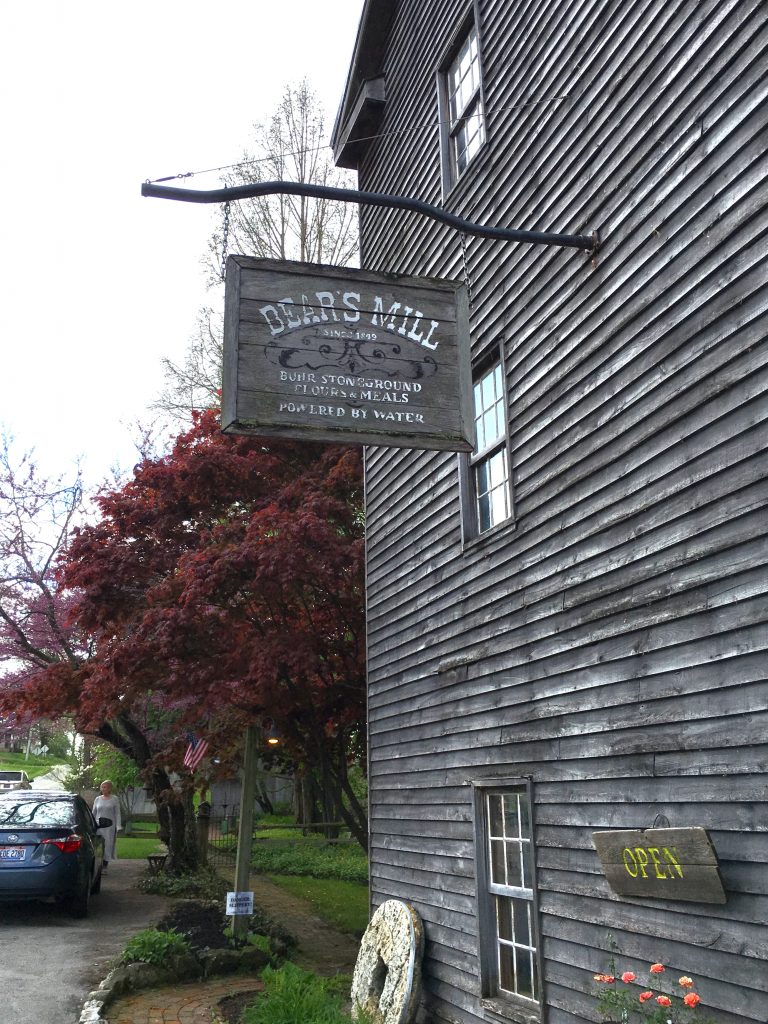
Sitting on 35 acres, historic Bear’s Mill is one of the last gristmills available in the state of Ohio. Providing flour since 1849, this water-powered stone grinder continues to make stoneground flour. The mill offers self-guided tours, seasonal celebrations, and local art.
Listed on the National Register of Historical Places, visitors can learn about the workings of a water-powered mill. Built by German immigrant Gabriel Baer, the location is rich with history. Interestingly, the name of Gabriel was documented as Bear, translated in error when he arrived to the United States.
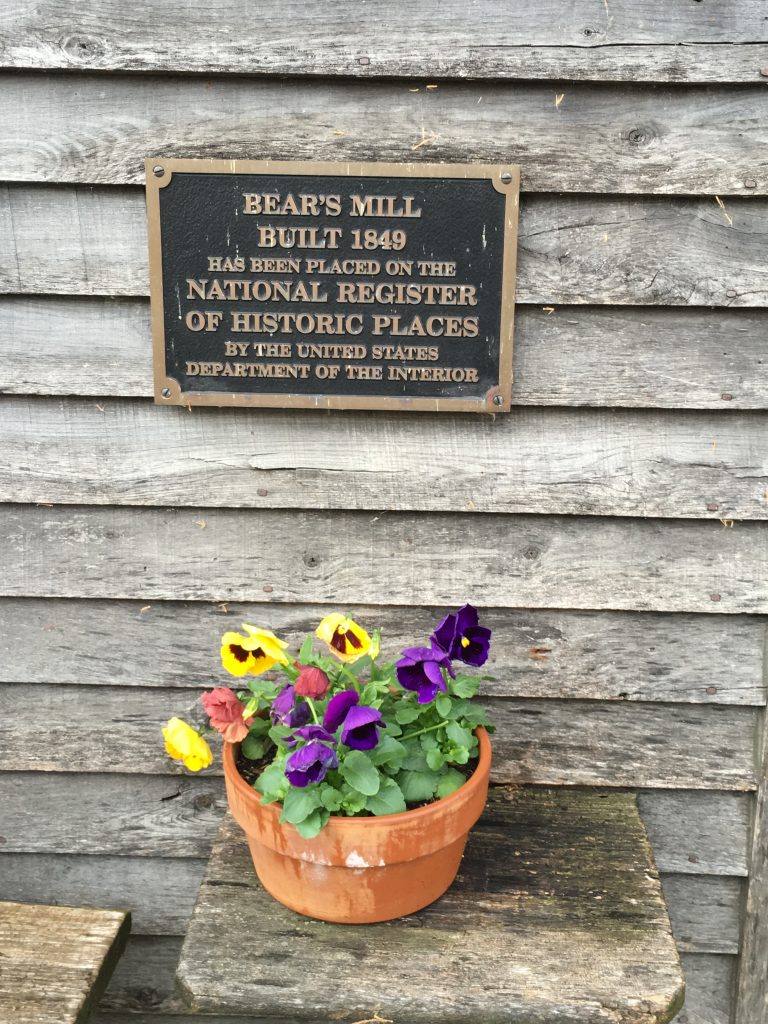
Built using American Black Walnut siding, the interior beams range from 12 x 16 and 50’ long in one continuous piece. The site of the mill was granted to Major George Adams by President James Monroe in 1824. In 2001, the siding was restored to its original condition with the help of the Friends of Bears Mill, a non-profit organization. .

Entering the mill on the first floor, there is a small shop that offers flour produced by the mill as well as local products and kitchenware.
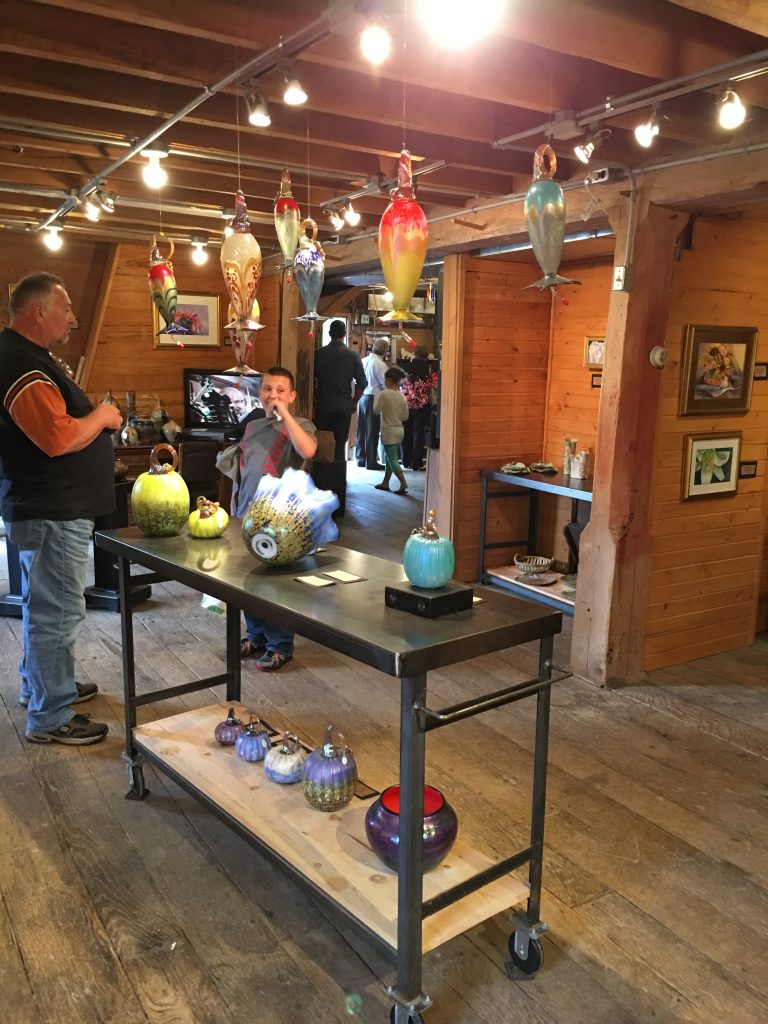
In an adjacent room on the first floor is an additional shop that displays local artwork available for purchase. While there is a permanent collection of pottery created by the miller’s wife, every six weeks, the mill hosts a rotating art exhibit on the final Friday of the month to Monday. Visitors can also meet the artist and purchase their work through the gallery.
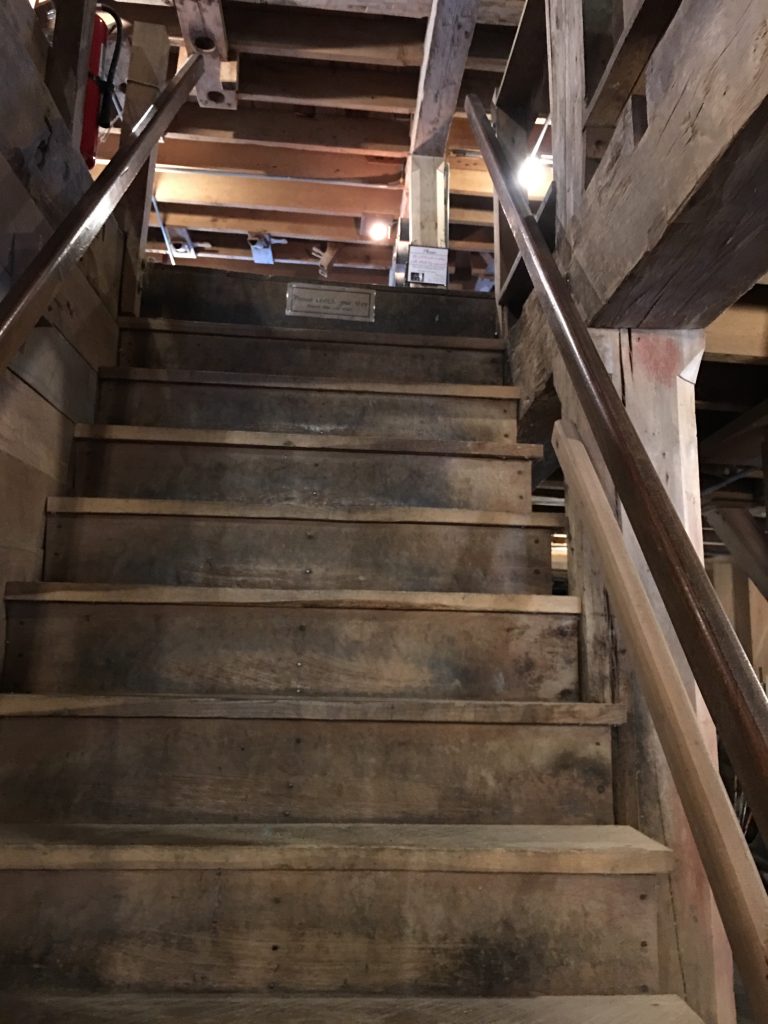
Starting at the base of the stairs of the first floor, I began my self-guided tour of Bear’s Mill. While the tour begins on the fourth floor, the first floor is also the where the production of flour begins.
The local farmer would pull up to the entrance with his sacks of grain, ringing the bell to alert the miller. The miller would lower a rope so that the farmer could send his bags up to the miller on the fourth floor.
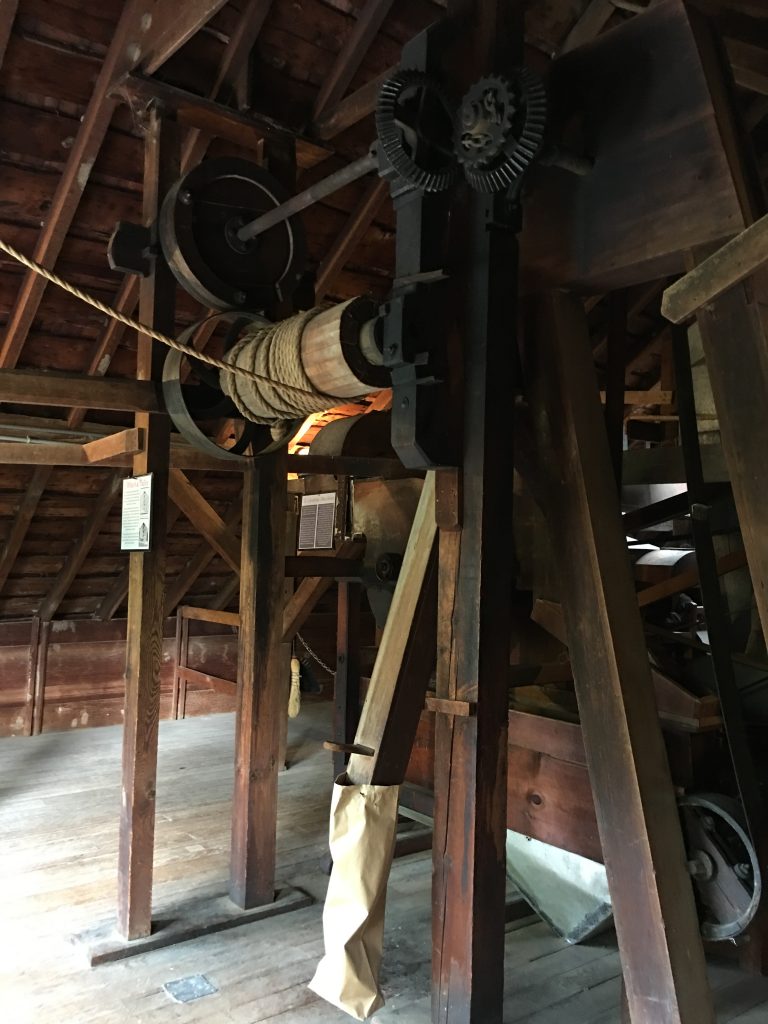
Weighing in at 100 pounds each, it was much easier for the miller to use a winch and pulley system to bring in the grain to the fourth floor. As a gravity fed mill, the process of producing flour starts at the top and proceeds downward.
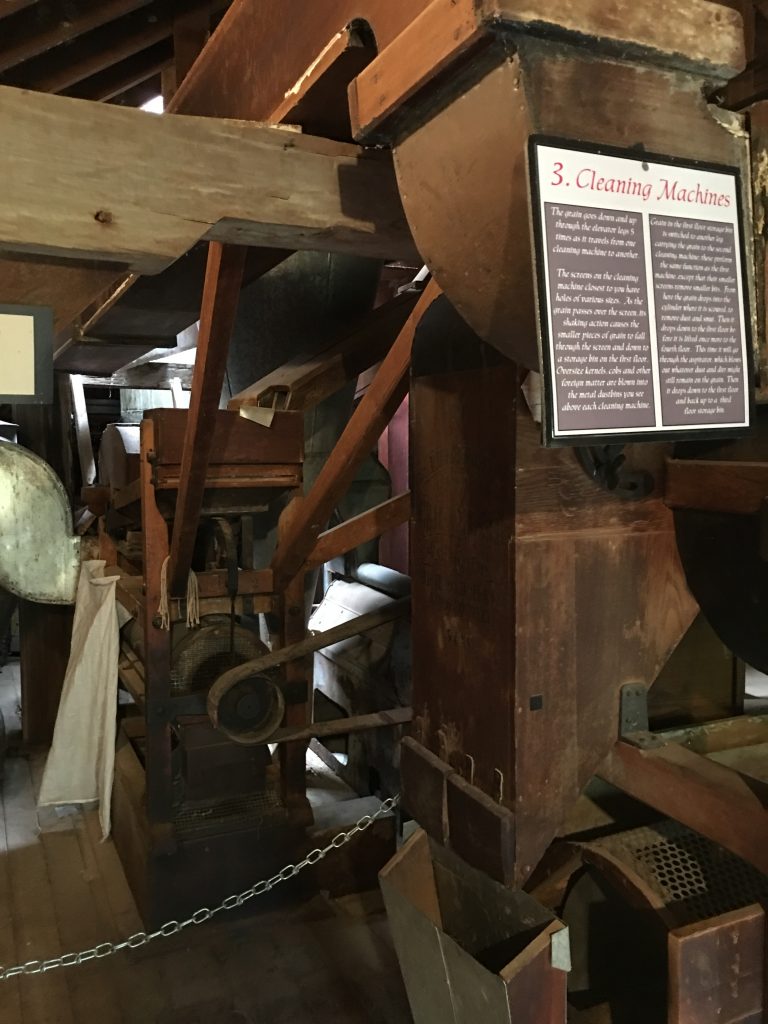
Once the grain has been hoisted to the top floor, it is put into a hole in the floor and stored in bins until the grain is ready to be cleaned. During the cleaning of the grain, the kernels will travel up and down the mill through the elevators five times before the process has been completed.
The cleaning process includes the shaking of the grain through screens so that the larger pieces such as cobs, kernels, leaves, etc. are removed. This process is conducted twice until the remains are dropped into a cylinder traveling to the first floor and ready for the next step.
The cleaning process continues as dust and smut are removed from the grain. Once again, the pieces of grain will end up on the first floor but must be moved to the fourth floor so that the grain will be blown by an aspirator so that remaining dust and dirt is removed. Once the grain travels back down to the first floor, it will be brought up to the third floor where the milling process will continue.
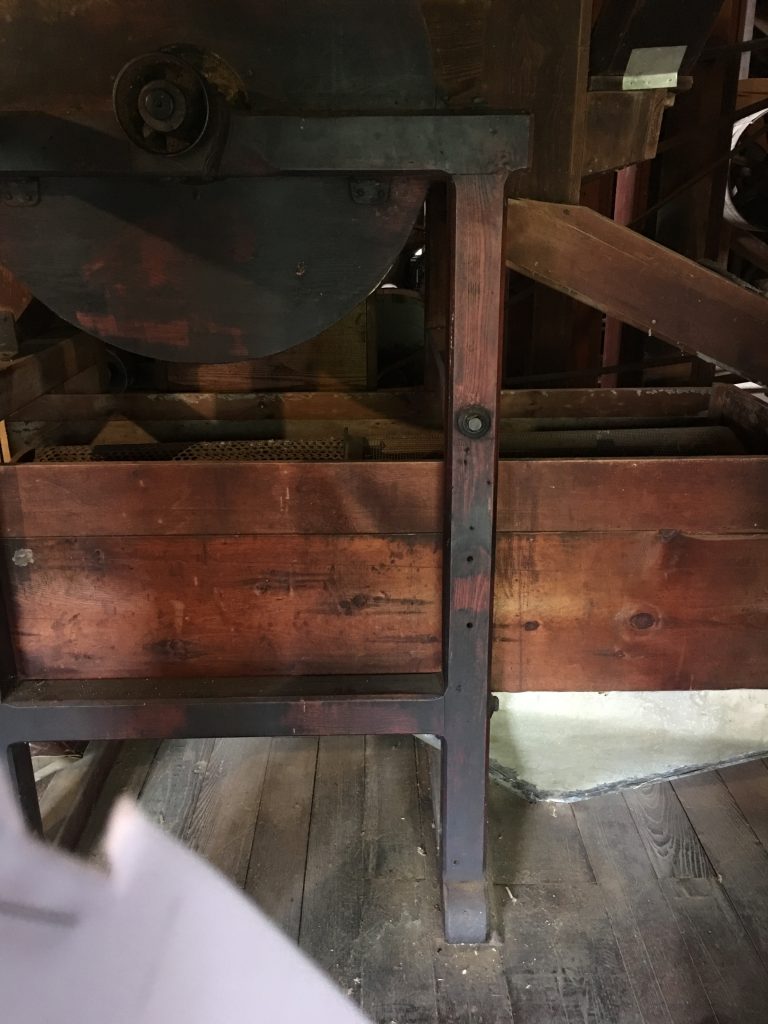
In preparation of the milling process, the buckwheat, corn and wheat is stored in bins on the third floor. This floor was also a great place for the farmer to wait until the flour had been ground. Here they would sell other produce they brought along, catch up on local gossip or play games such as checkers or cards.
The milling process begins when the grain is put into chutes channeling the grain towards the hopper located over the buhr stones.

Browsing the third floor, there are some interesting items to include the scale which could weigh up to six hundred pounds of grain, elevator legs and the buhr stones. I enjoyed browsing the authentic Darke County Fair posters as well as the sale bills that displayed the livestock and produce the locals would have been selling.
The French buhr were the most sought after millstones due to their abrasive and porous qualities as the result was a slow grinding process. Have you ever heard the old adage, “Keeping Your Nose to the Grindstone?” During the grinding process, the miller would need to keep watch over the grindstones to ensure that they did not overheat, causing an offensive burning smell.
The buhr stones on display at Bear’s Mill were the original stones that Gabriel Baer imported in 1848 talking two years to eventually reach the United States. Costing $6000 in the mid-1800s, this would be equivalent to about $140,000 today.
Bear’s Mill did not utilize the typical water wheel system but rather used turbines which was a more modern technology of this time. The turbines are approximately 10 feet below the water, working just as they had over 150 years ago.
Exploring Bear’s Mill was such an amazing history lesson and insight into the technology of grain making in the mid-1800s. I was happy that the mill continues to produce various flours and sells it on-site with additional gourmet foods.
Have you visited Bear’s Mill in Greenville? What did you think of the flour-making process? Did you purchase any items from the store? I would love to hear about your experience if you would kindly leave a message in the comments section below. Many thanks for reading about my day trip to Bear’s Mill and wishing you many Happy Travels!
UPDATE: Check out bonus information below!
What to See and What to Do:
Bear’s Mill
6450 Arcanum – Bear’s Mill Road
Greenville, OH 45331
937 548 5112
- Admission Fee: There is no admission fee, but donations are welcome.
- Hours: The mill is open Tuesday and Wednesday from 10AM to 4PM; Thursday thru Saturday from 11AM to 5PM and Sunday 1PM to 5PM.
- Length of Visit: 1 – 2 hours
- Tips for Your Visit: Wear comfortable shoes for hiking. Look for albino squirrels at this park.
Where to Stay:
The Inn at Versailles
21 West Main Street
Versailles, OH 45380
Telephone: 937 526 3020
Where to Eat:
The Merchant House
406 South Broadway
Greenville, OH 45331
Telephone: 937 459 4405
Where to Drink:
Kennedy Vineyard
3911 State Route 722
New Madison, OH 45346
Telephone: 937 273 8381

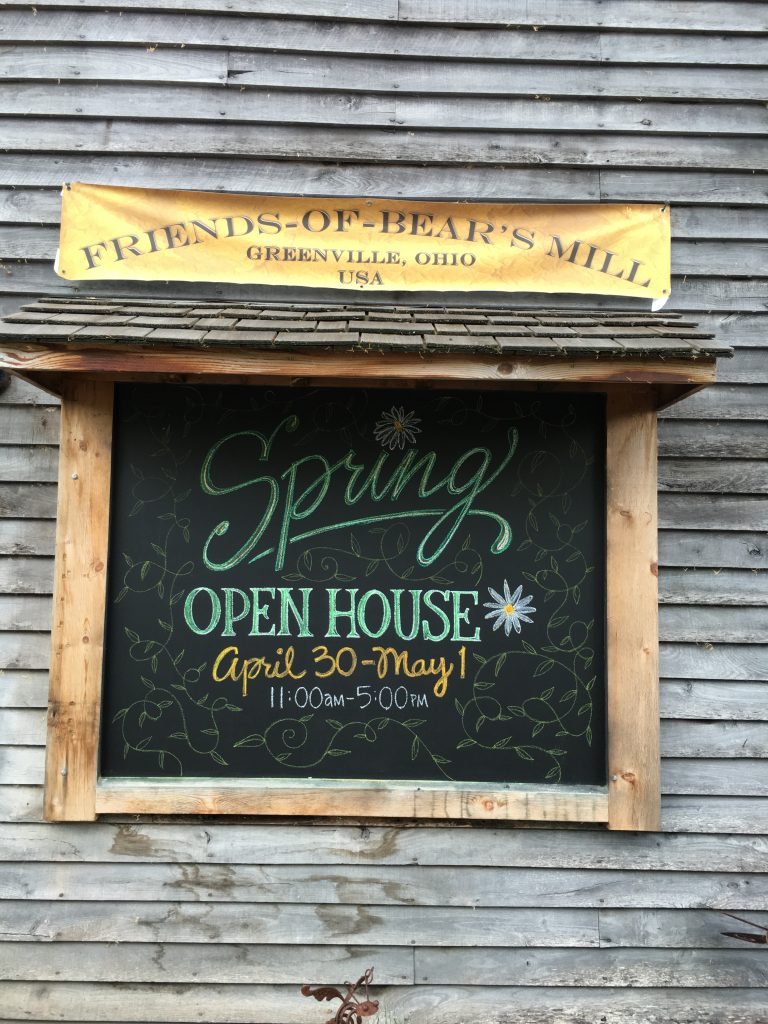

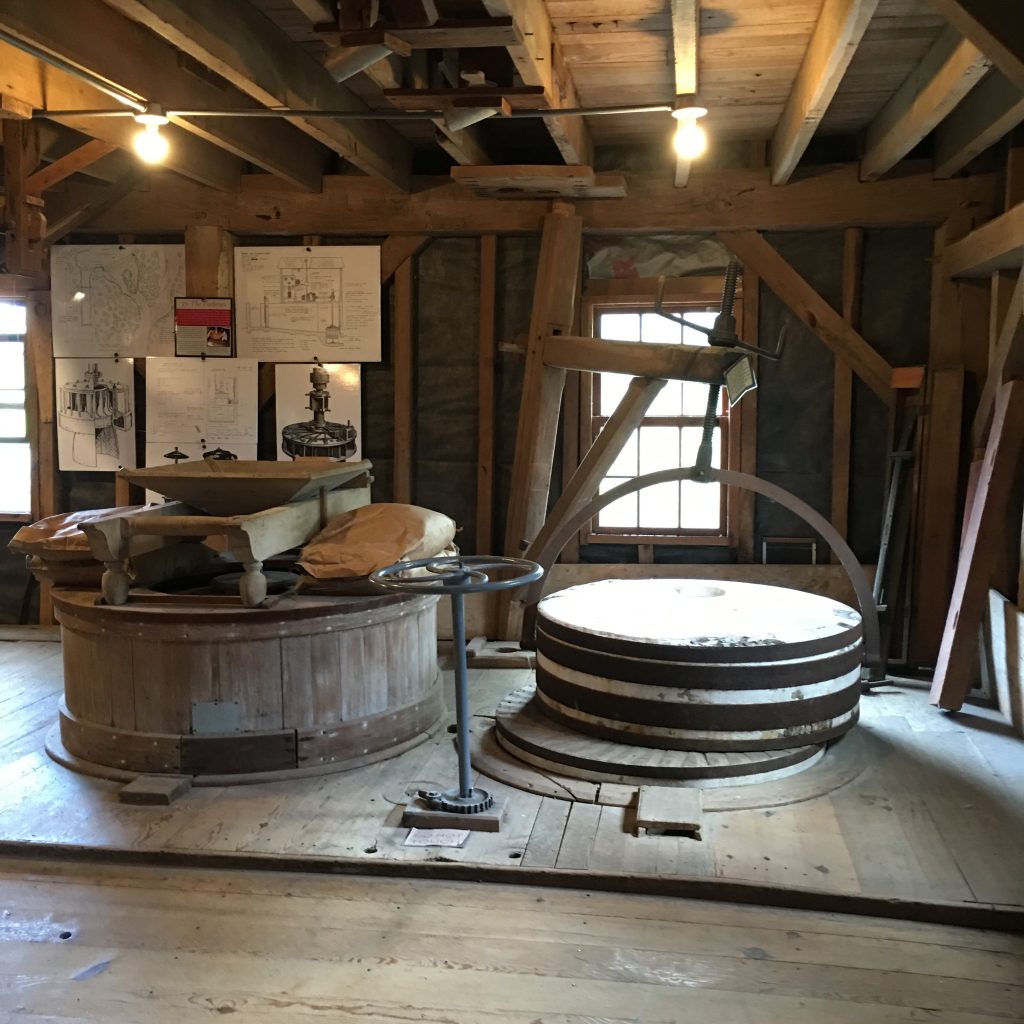
On a second visit to Bear’s Mill, I learned that there is a scenic walking path that leads towards the back of the mill. Here are some photos from the trail.
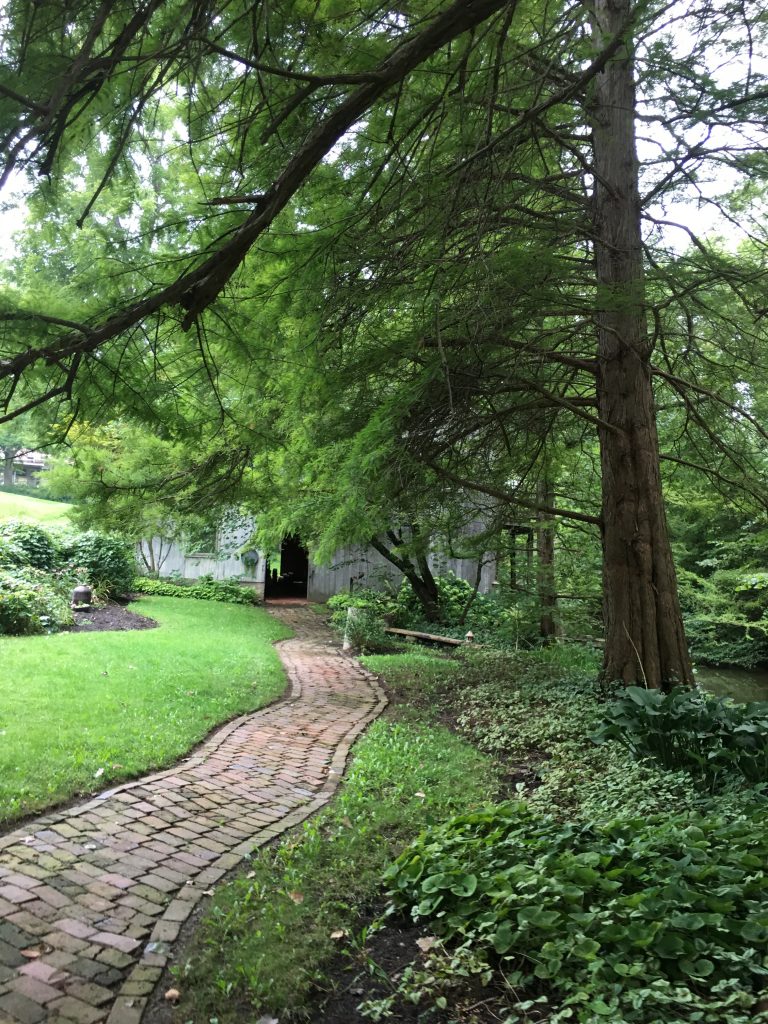
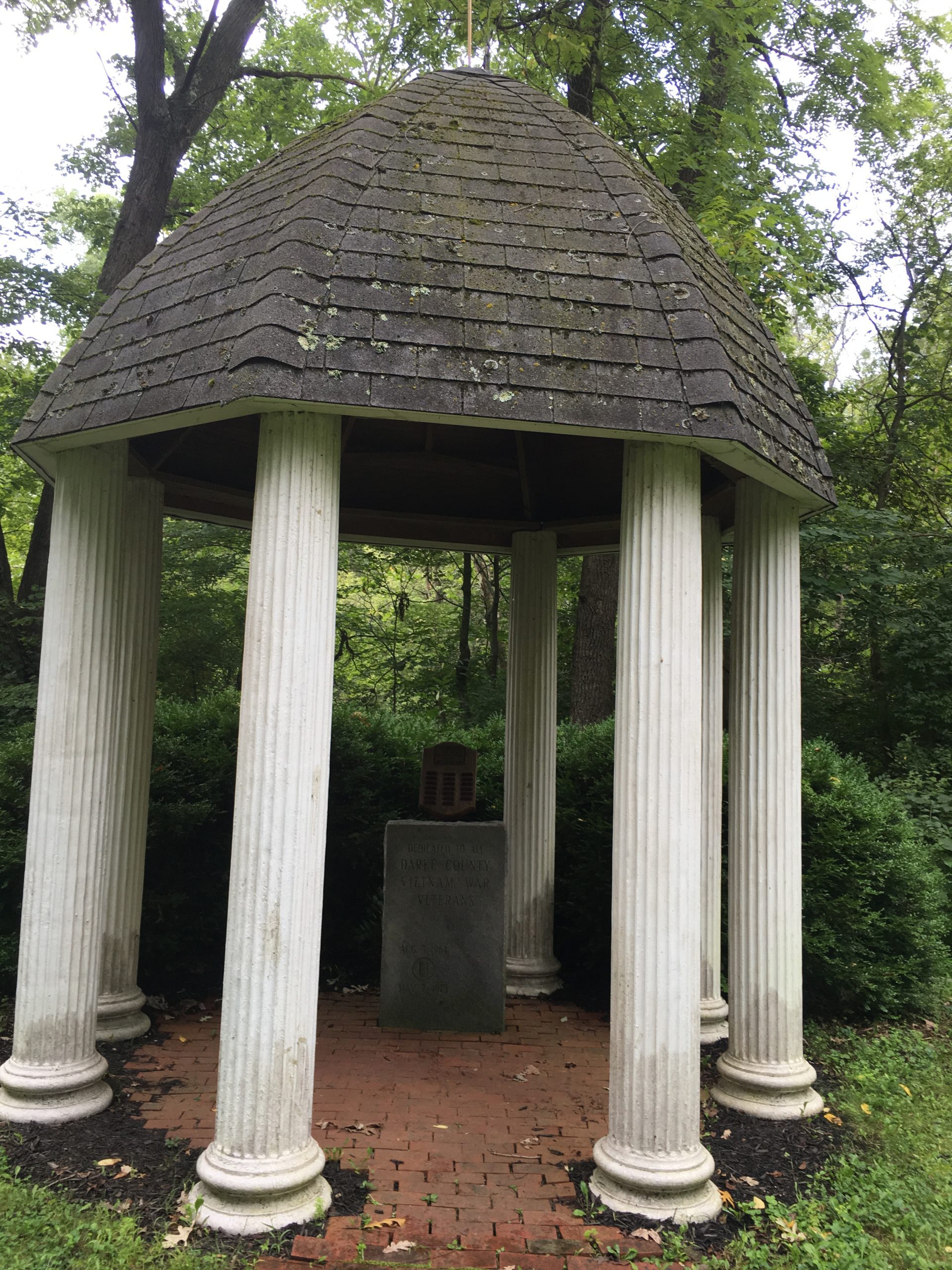
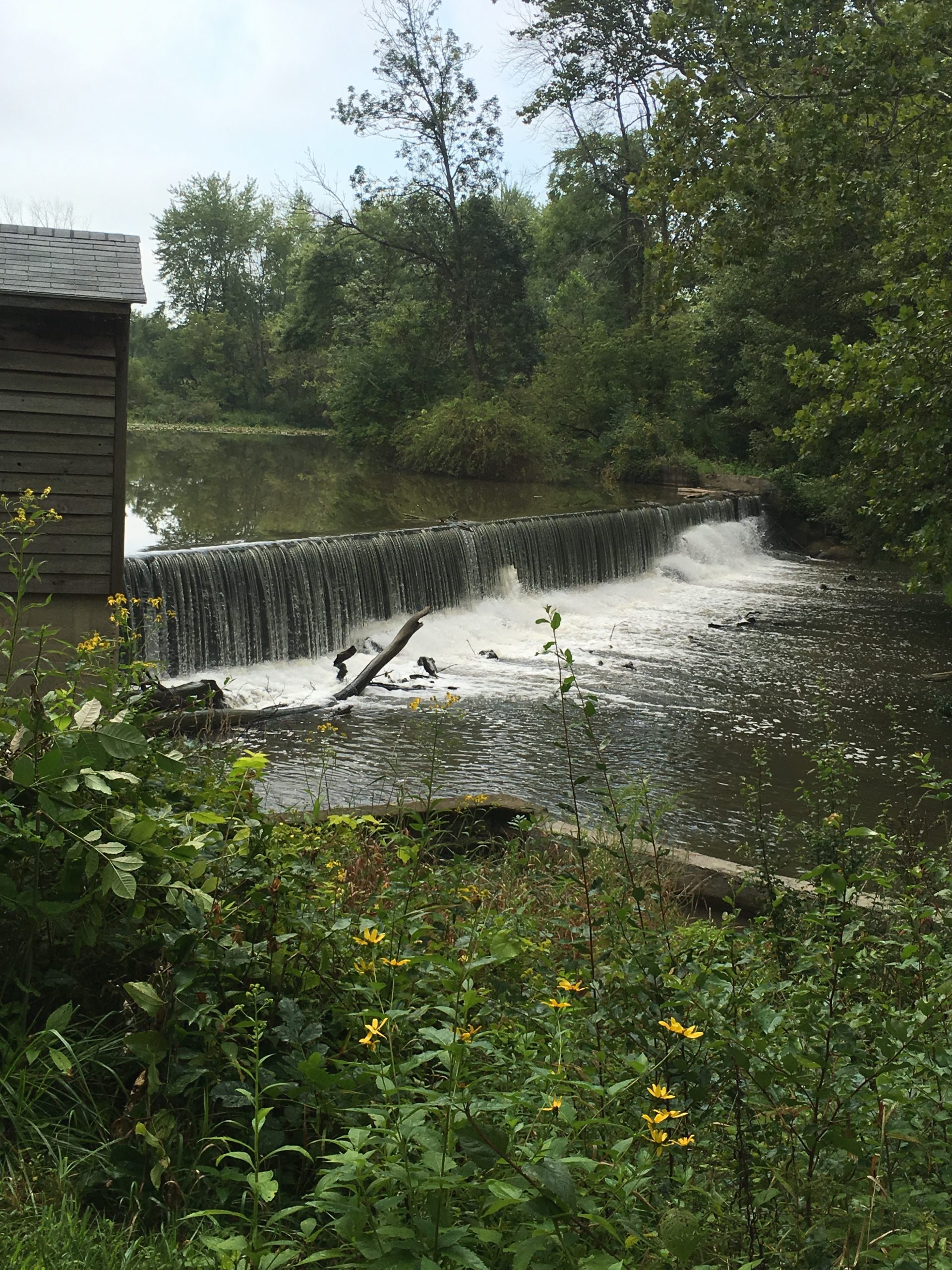
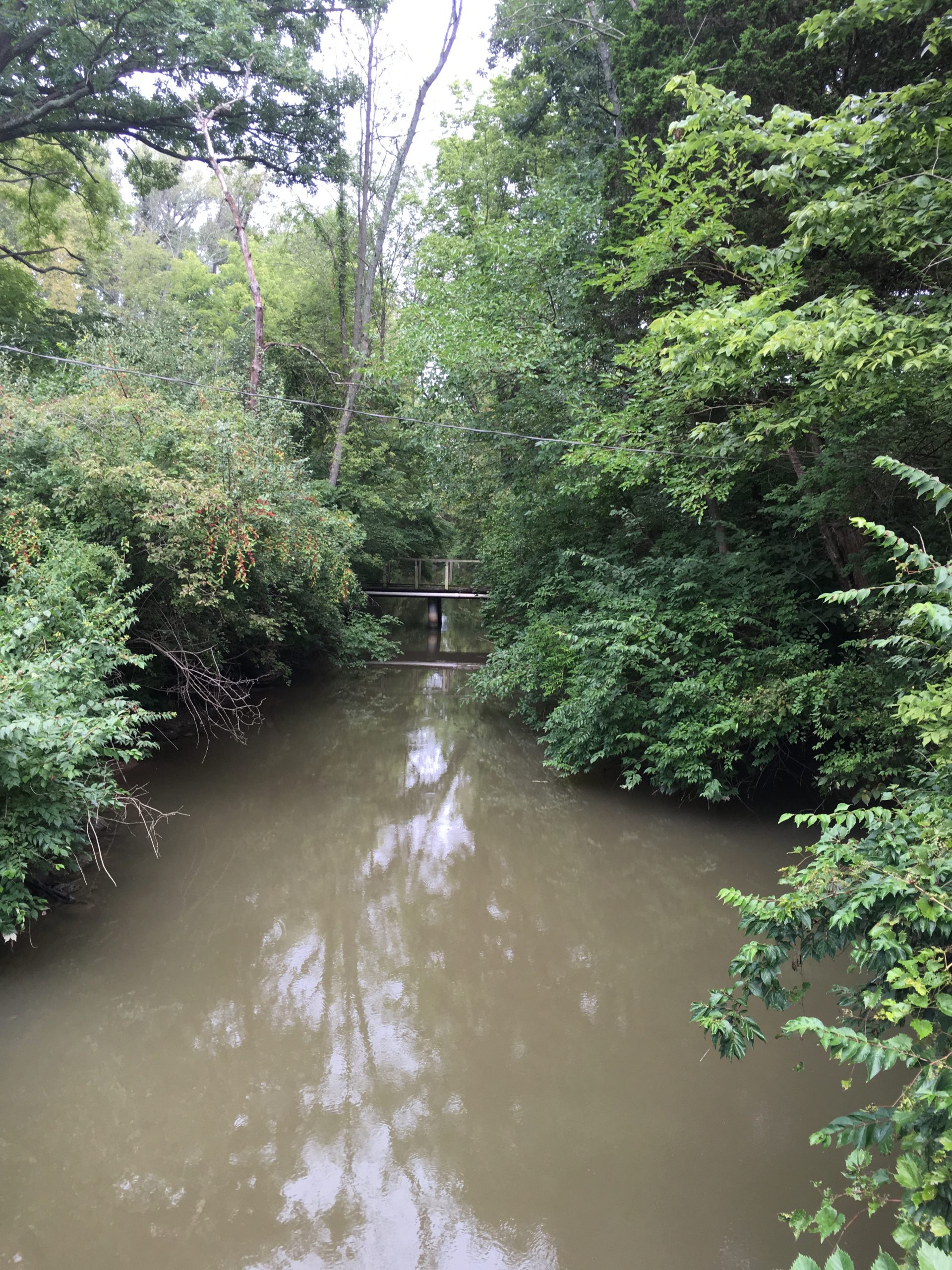
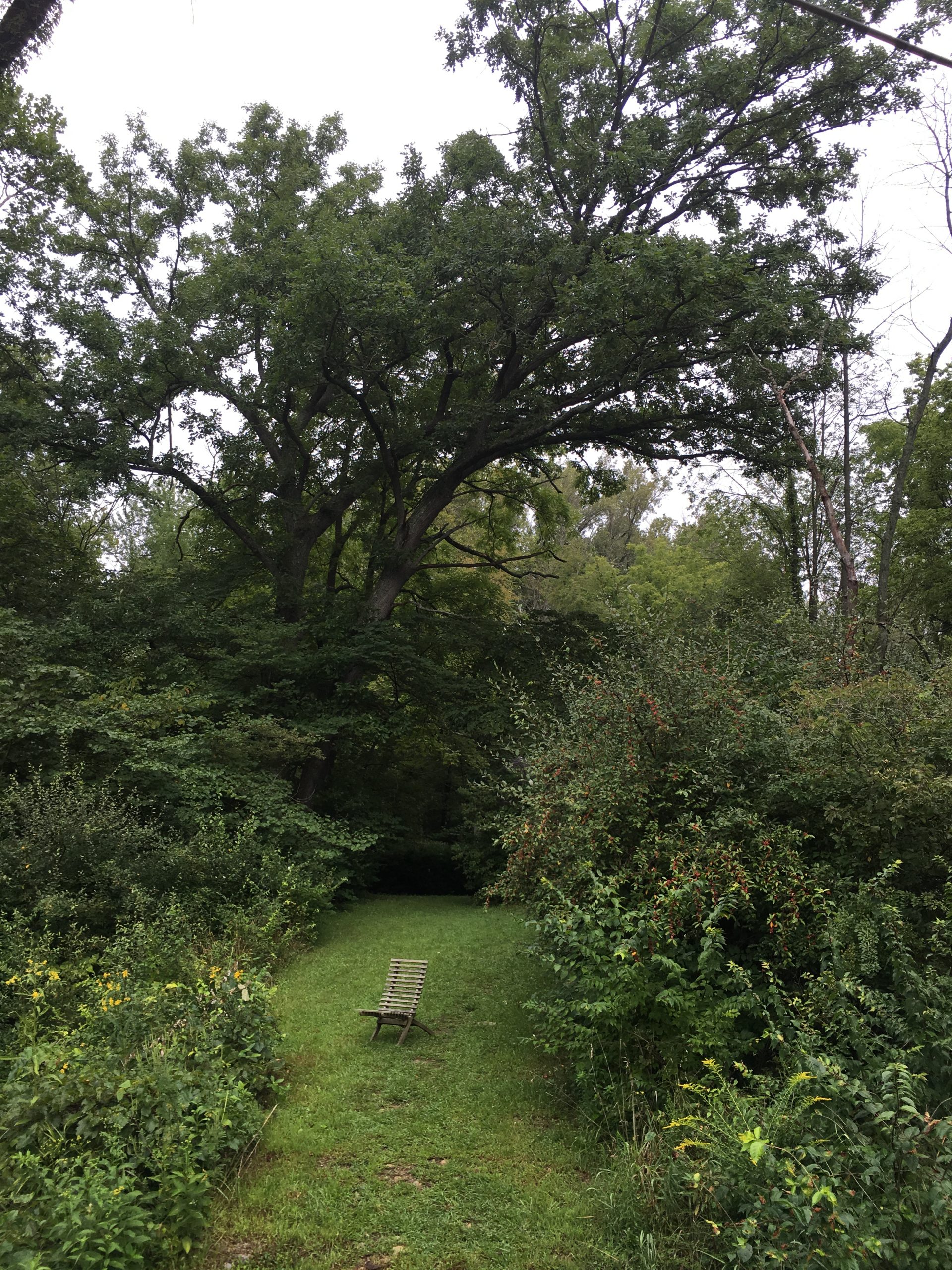
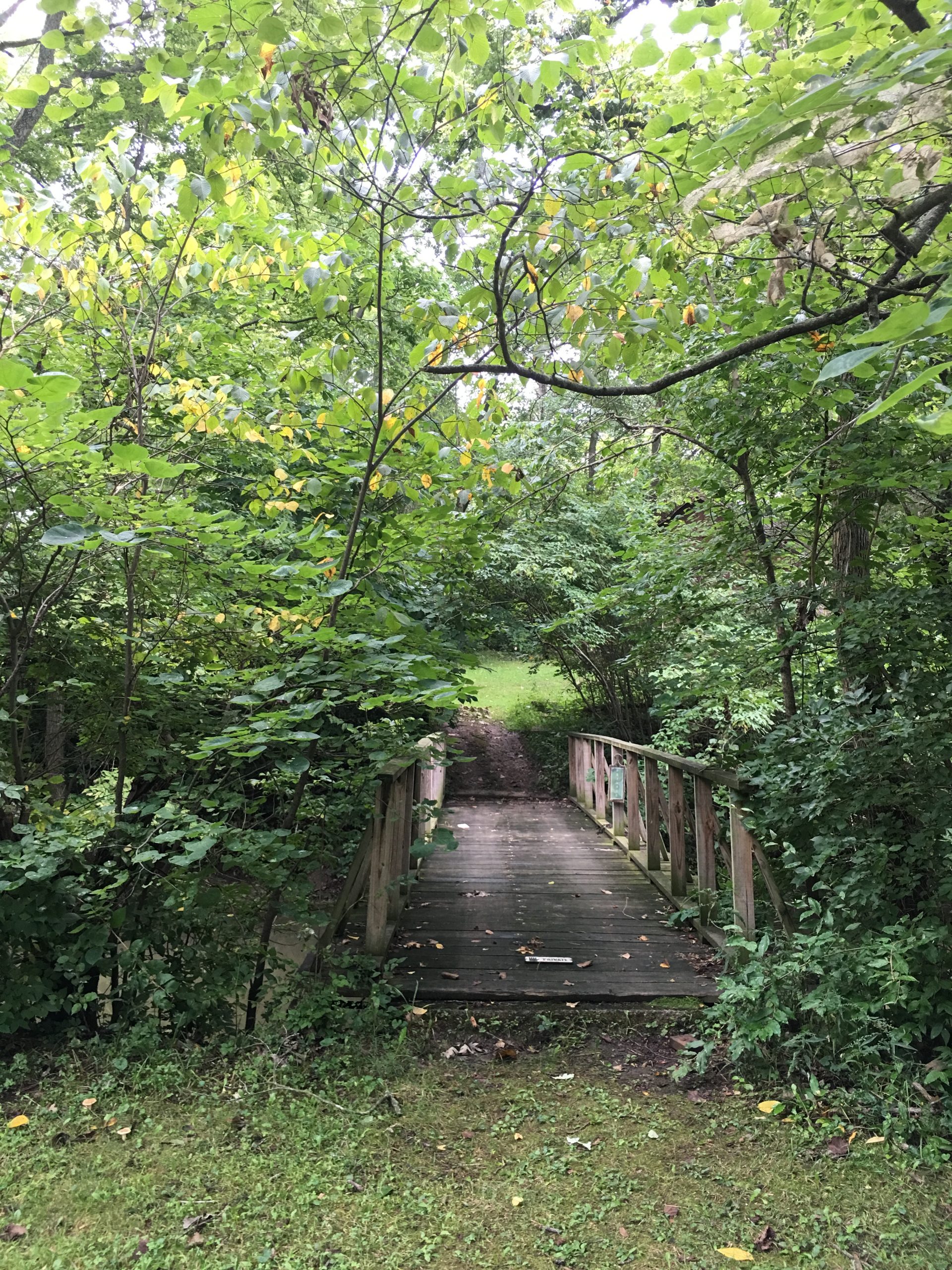
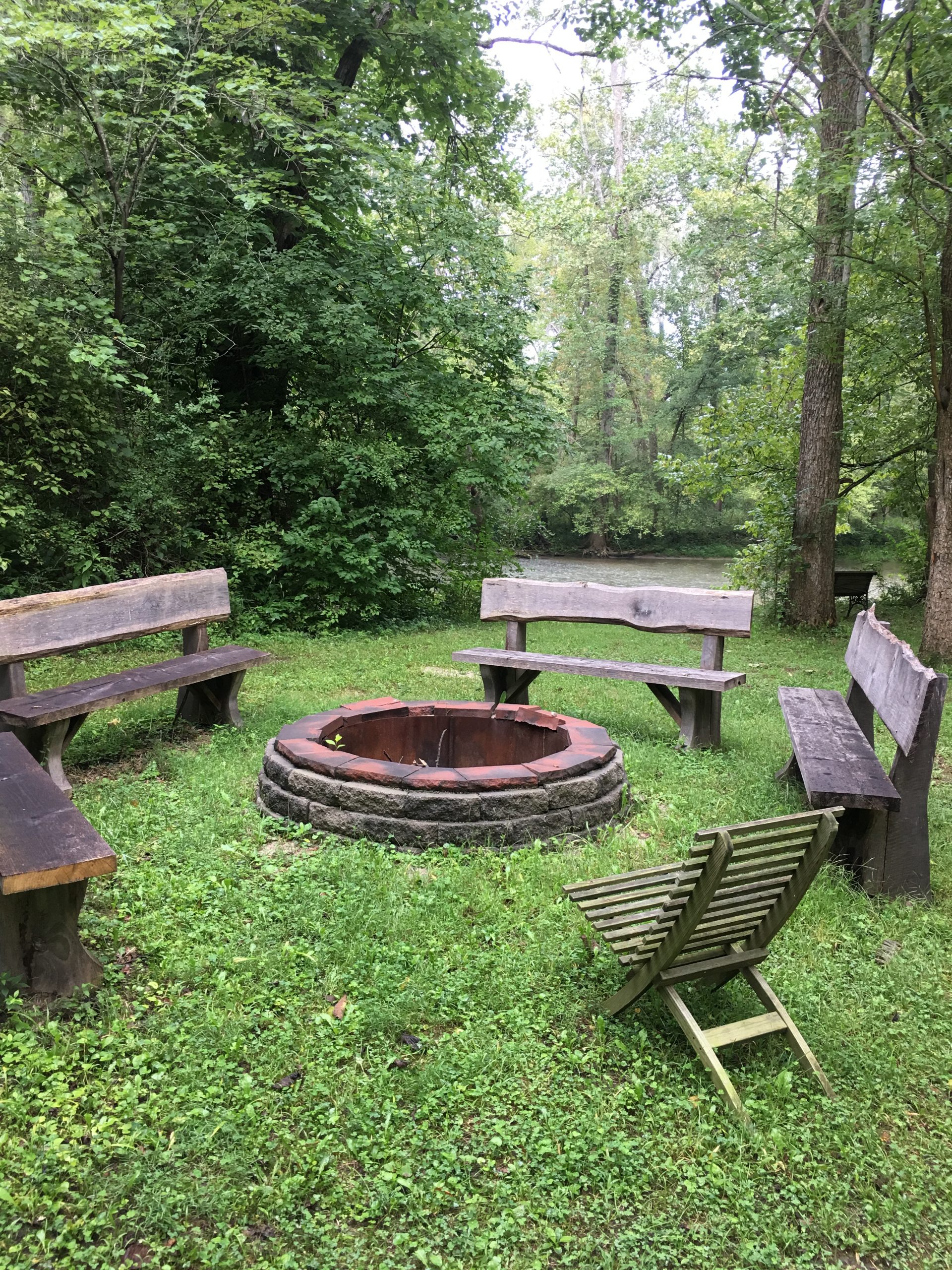

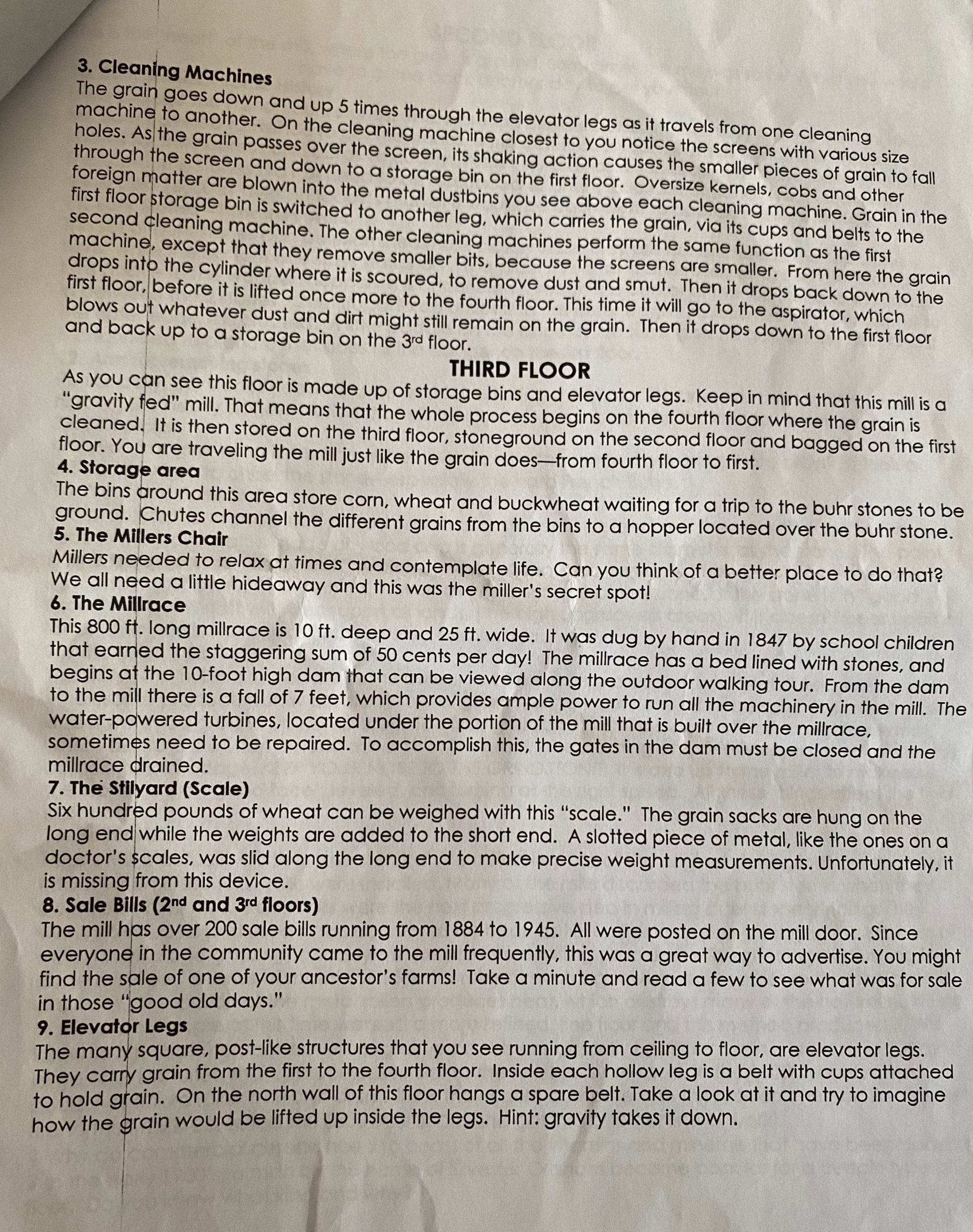
The Garst Museum and Greenville’s Early Beginnings
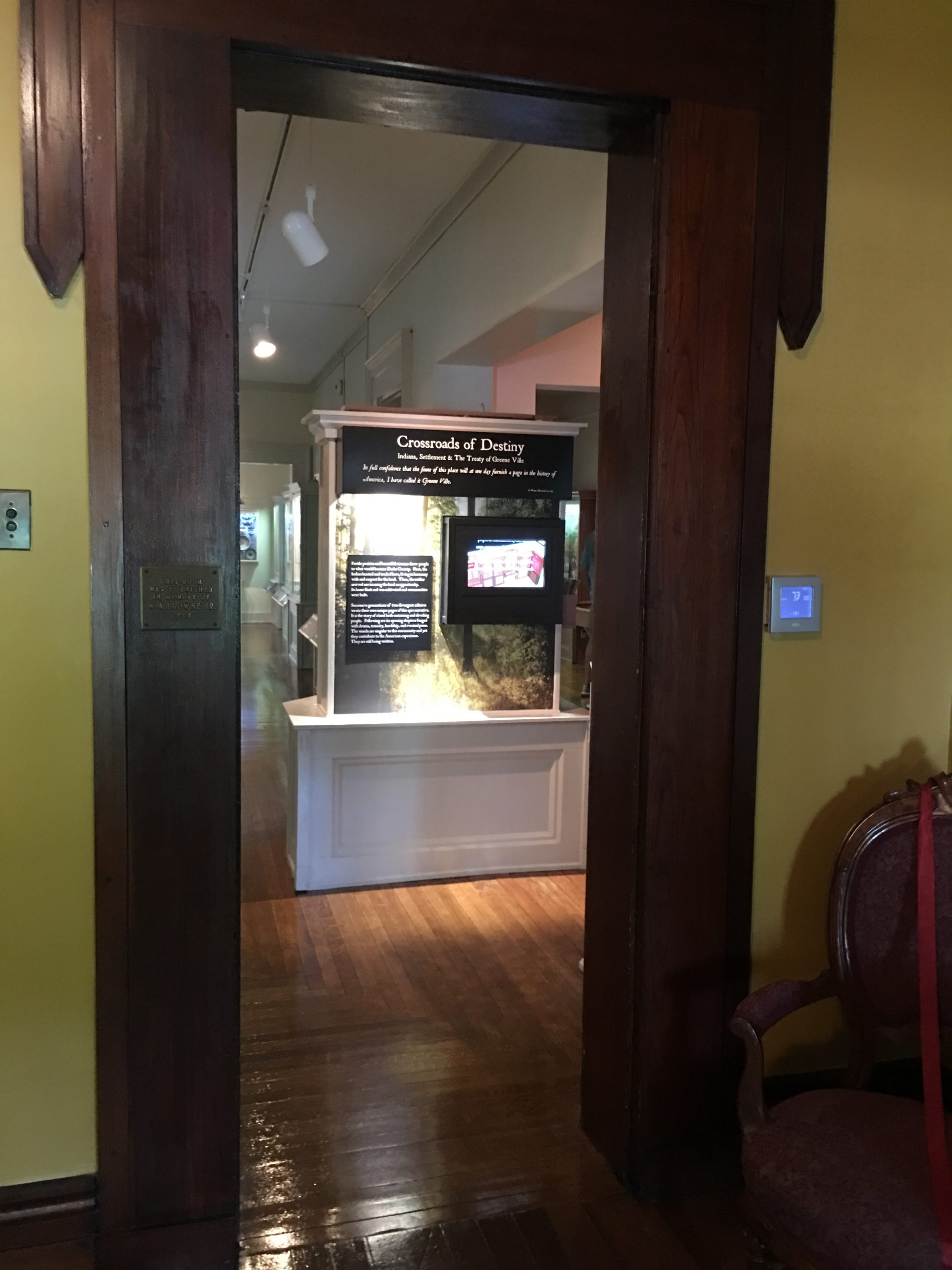
As I entered the Garst Museum, it was eerily quiet as I passed through the threshold of a beautifully restored campus house. A table stood in the entryway with several flyers and maps to assist me with touring the galleries. To the left I began my exploration of Greenville’s history titled “Crossroads of Destiny” and found several materials pertaining to this venue.

Starting with the Paleo period are remains of prehistoric animals that once roamed this area of Darke County. On display are several bones and teeth of a Mastodon and Wooly Mastodon which were hunted by the Paleo Indians between 6,000 and 13,000 BC.
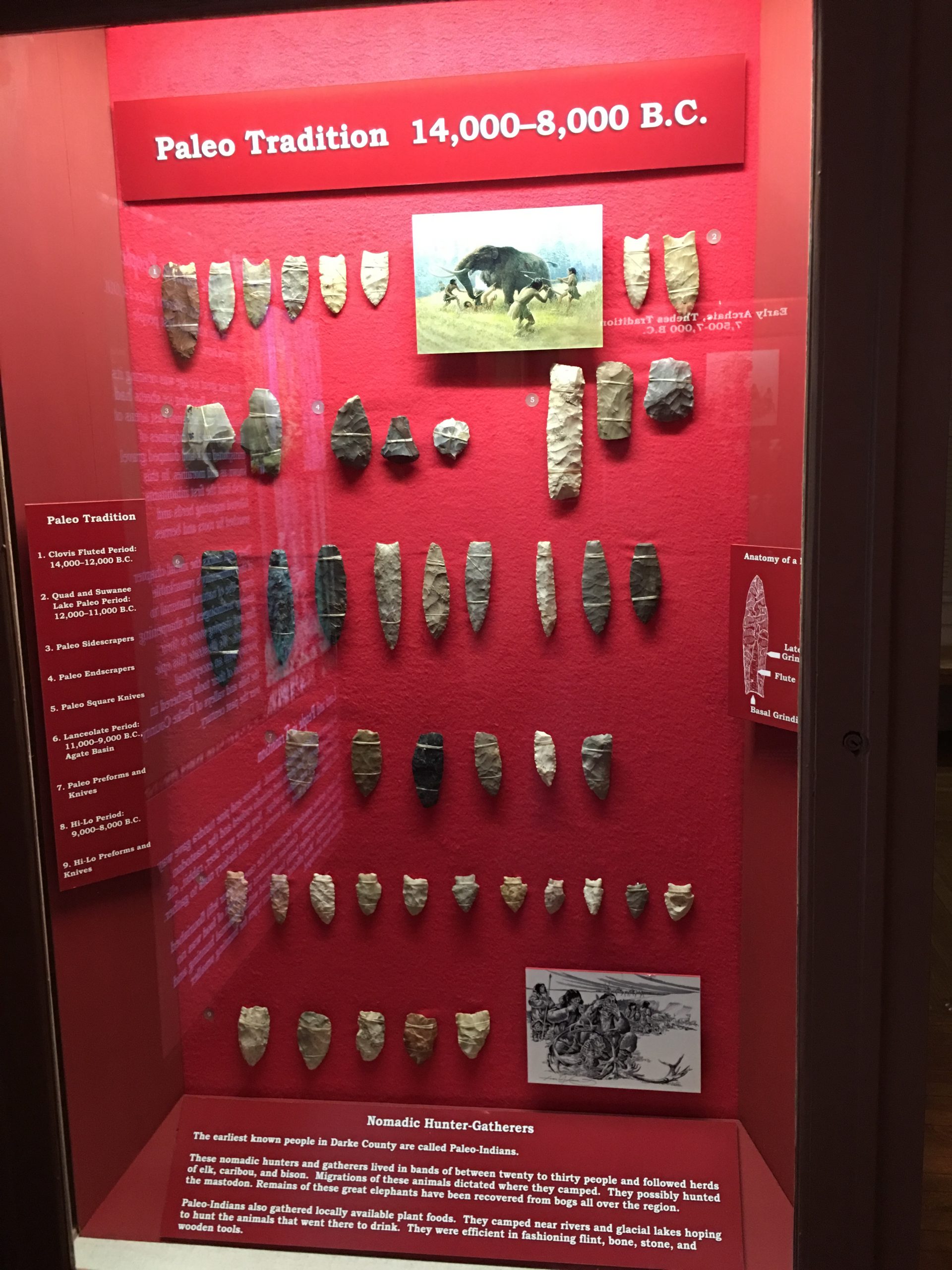
In addition to the animal finds are arrowheads dating back to the Paleo and Archaic Periods. Used for hunting and spearing fish, the Indians gradually improved their weapons and tools to include chisels and axes.
By the early 1600s, the English made their way to the New World and settled along the East Coast. In hopes of more opportunities, they began to move west, encroaching on Indian Territory. Fighting broke out between the Indians and the European Americans which eventually led to the 1795 Treaty of Green Ville. The “treaty of peace” included a cease fire between the Indians and Americans, provided compensation to the Indians in exchange for land that included two-thirds of southeast Ohio.
Additional treaties were signed and eventually the Indians were forced to settle in the West. At this point, Tecumseh, a Shawnee Indian from modern-day Columbus, Ohio was determined to fight against the loss of their land by the Americans, but his efforts failed. Eventually, Tecumseh joined the new Americans and fought in the War of 1812, where he died in October of 1813. The story of his life is depicted in an outdoor drama titled, “Tecumseh” which is performed during the summer months in Chillicothe, Ohio.
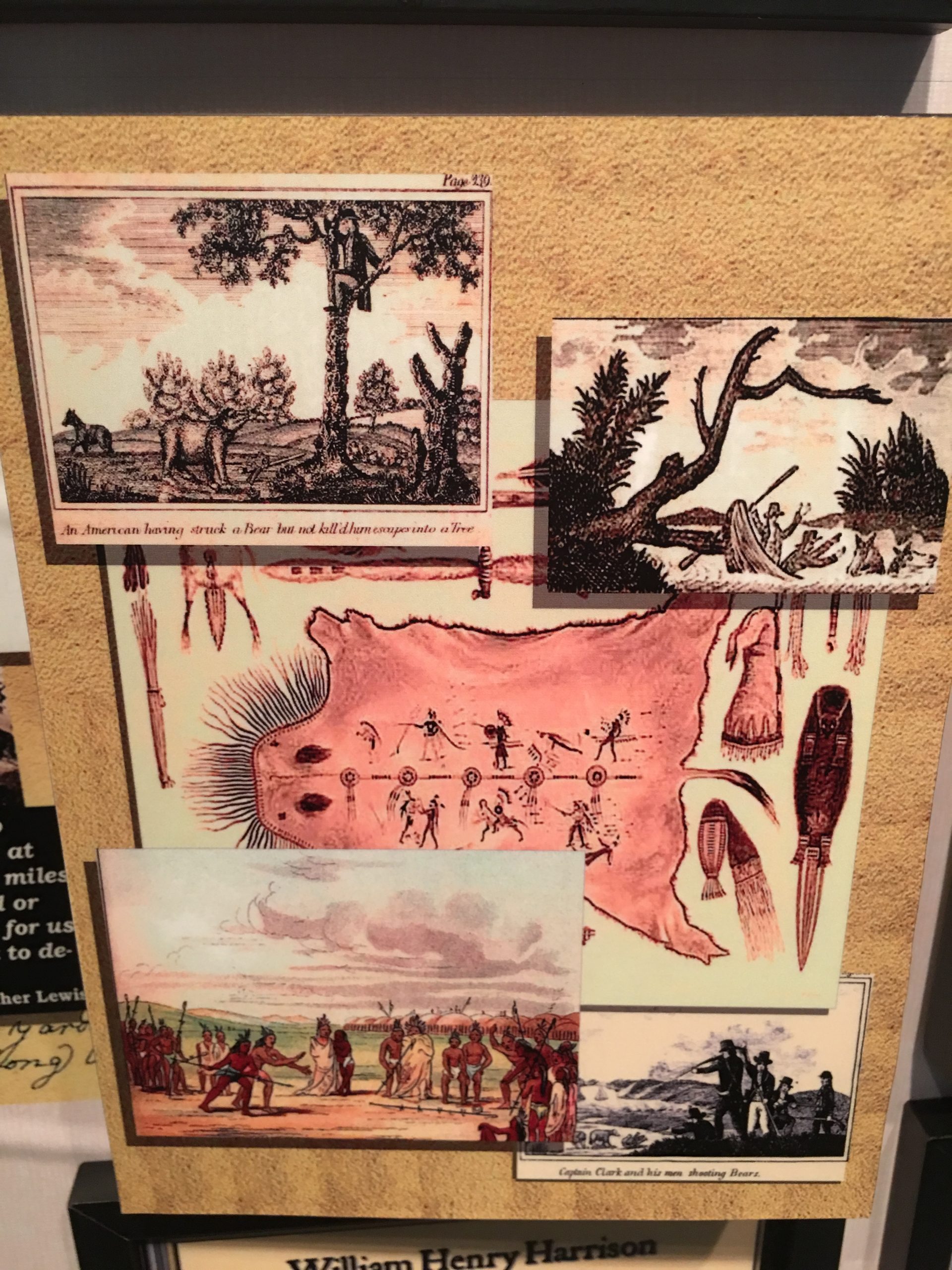
Growing up about an hour east of Greenville, I was familiar with the historic figures from the area such as Blue Jacket and Simon Kenton. Blue Jacket was a Shawnee War Chief who fought against American settlers who were in pursuit of the Indian’s land. He was defeated in 1794 during the Battle of Fallen Timbers which resulted in his signing the Treaty of Greenville in 1795, ceding to the settlers. Each year, the city of Xenia hosts performances of the outdoor drama ,”Blue Jacket” in a gorgeous, scenic amphitheater in remembrance of this local celebrity.
Simon Kenton was also a key figure as a frontiersman who was a friend of Daniel Boone. Kenton also fought alongside George Rogers Clark during the Revolution. Kenton was kidnapped by the Shawnee Indians on several occasions. Impressing the Shawnee by his ability to escape, he was eventually adopted by the Shawnee as they lived harmoniously in what is known today as Champaign County. He is buried in Urbana.
Today, Greenville is known for its farming of corn and soybean. Visitors can take a step back in time to visit Bear’s Mill, a working gristmill that sells freshly ground flour in their gift shop. Greenville’s Main Street is a great way to spend the afternoon with a visit to the Anna Bier Gallery displaying the artwork of local artists. My favorite stop is the KitchenAid experience to browse the latest KitchenAid mixers and gadgets for sale. In addition, the store houses a museum that shows the evolution of the KitchenAid mixer since 1941. The Merchant House is a highly recommended stop for lunch or dinner or venture to nearby Versailles for a local winery experience and its charming downtown.
From its humble beginnings to its modern day advancement in kitchen appliances, Greenville is an incredible historic stop and one of America’s greatest examples of Main Street, America.
Have you visited Greenville? What activities and restaurants did you decide to visit? I would love to hear about your experience if you would kindly leave a message in the comments section below. Many thanks for reading about my lovely afternoon in Greenville and wishing you many Happy Travels!
What to See and What to Do:
Garst Museum
205 North Broadway
Greenville, OH 45331
Telephone: 937 548 5250
- Admission: $12 for adults, $11 for seniors, $9 for youth, $9 for Darke County Genealogy Society Members, Free for children aged 5 and below and for DCHS Members
- Hours: Tuesday – Saturday from 10AM to 4PM & Sunday from 1PM to 4PM, Closed Mondays, Major Holidays and the Month of January
- Amenities: Historical exhibits, educational exhibits, research center, historic figures, museum store and special events
- Tips: Allow yourself plenty of time to visit each of the exhibits and wear comfortable shoes.
Where to Stay:
The Inn at Versailles
21 West Main Street
Versailles, OH 45380
Telephone: 937 526 3020
Where to Eat:
The Merchant House
406 South Broadway
Greenville, OH 45331
Telephone: 937 459 4405
Pig candy and the Monte Cristo sandwich….absolutely amazing!
Where to Drink:
Kennedy Vineyard
3911 State Route 722
New Madison, OH 45346
Telephone: 937 273 8381
What to Read:
- Annie Oakley, by Charles J. Shields
- Annie Oakley: A Captivating Guide to an American Sharpshooter Who Later Became a Wild West Folk Hero, by Captivating History
- Life and Legacy of Annie Oakley, by Glenda Riley
- step back into timw
- historical destination with over 300,000 artifacts on display over 35,000 square feet of exhibit space within six building wings
- Major Exhibit Venues include:
- Crossroads of Destiny: The story of General Anthony Wayne, Little Turtle
- Lowell Thomas – pioneer broadcaster
- Military History – 1812 to War in Iran
- Commander Zachary Landsdowne – Captain of the Navy Airship USS Shenandoah and early advocate of military air power
- Early Pioneers & Period American Furnishings
- Early Village Settlement Shops
- Currier & Ives Collection
- Darke County Research Center
The Old Arcana, Arcanum Ohio – NOW CLOSED
UPDATE: The Old Arcana is now CLOSED.

What initially drew me to The Old Arcana Restaurant was their Bourbon Praline French Toast, which was voted the best by Ohio Magazine. I was also interested in visiting Bear’s Mill in Greenville, so I combined the two for a pleasant morning in Darke County, Ohio. Passing through cornfields and small country towns, my GPS guided me to Arcanum with its red brick streets and charming antique shops.
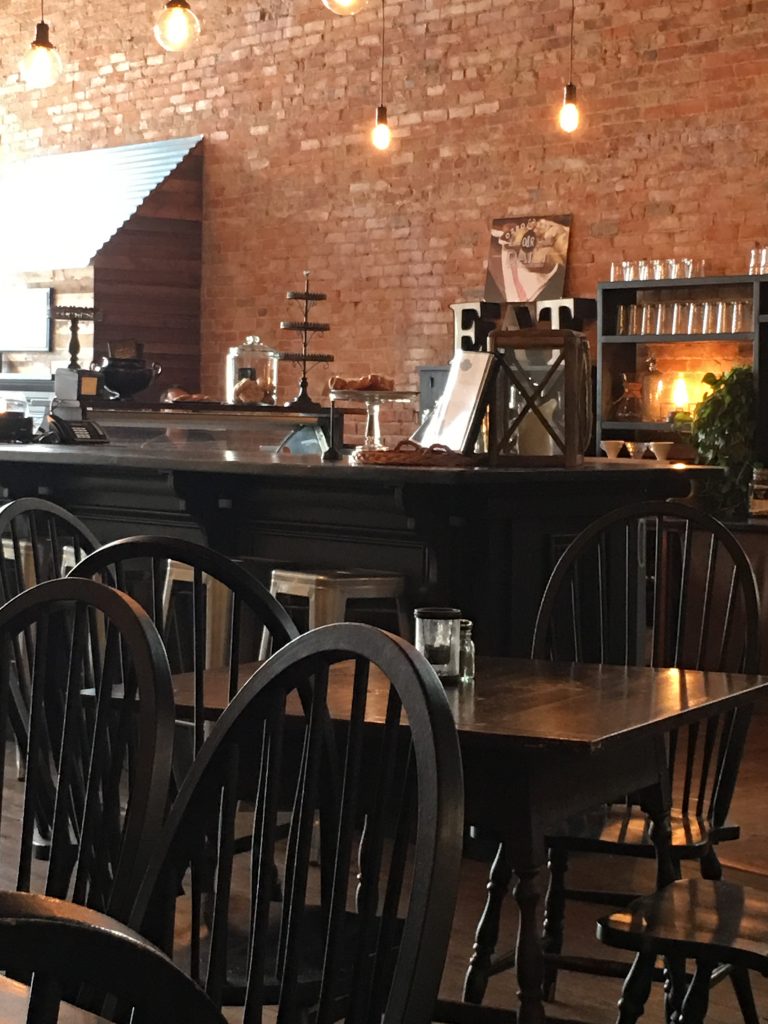
The beautiful interior was rich with exposed brick walls, dark wood furnishings and simple, yet elegant table settings. The bar is the main attraction displaying the homemade desserts in the glass enclosure at the front, while in the back, servers are ringing up orders and pouring their customer’s beverages.
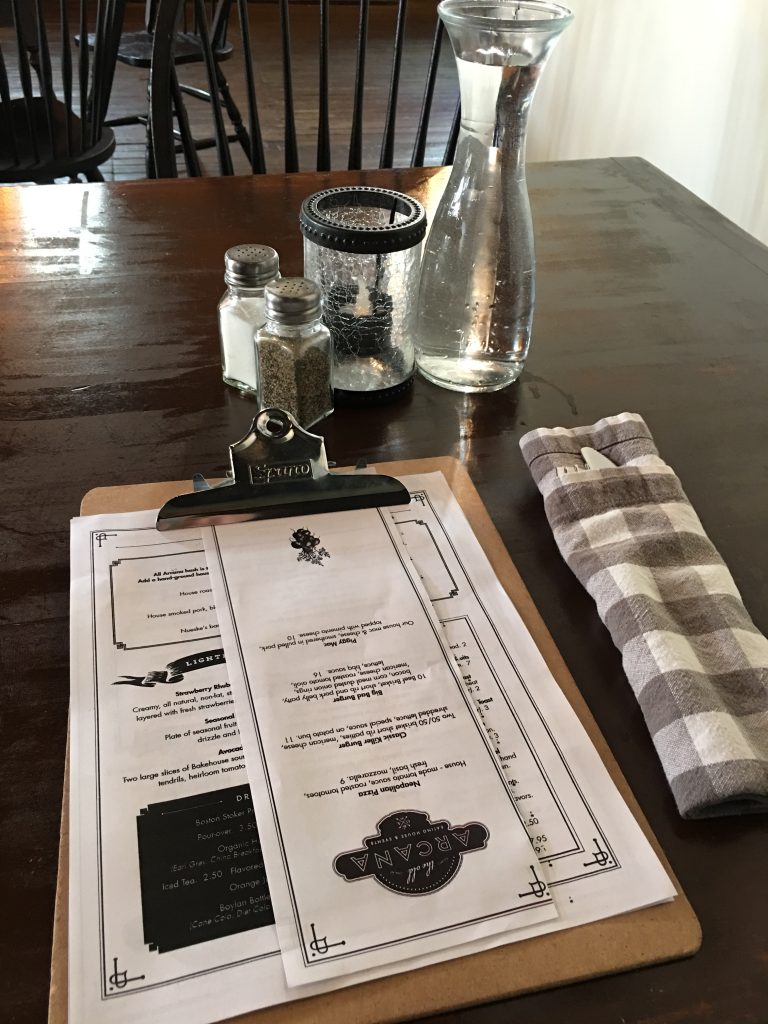
The menu offered a long list of Southern-style entrees with a few healthy options as well. My eyes were drawn to the sausage gravy and biscuits, three egg omelets with herb roasted potatoes or an order of pancakes and homemade syrup.
Lunch and dinner selections included comfort foods such as the Kentucky Hot Brown and burgers of fresh meat made from brisket. All menu items are made in-house with fresh ingredients purchased from local markets and farmers.
A unique list of starters such as falafel fries, deviled eggs and Reuben rolls, and an excellent selection of salads ranged in price from $6 to $8. While each item looked delicious, I was not swayed away from the Bourbon Praline French Toast.
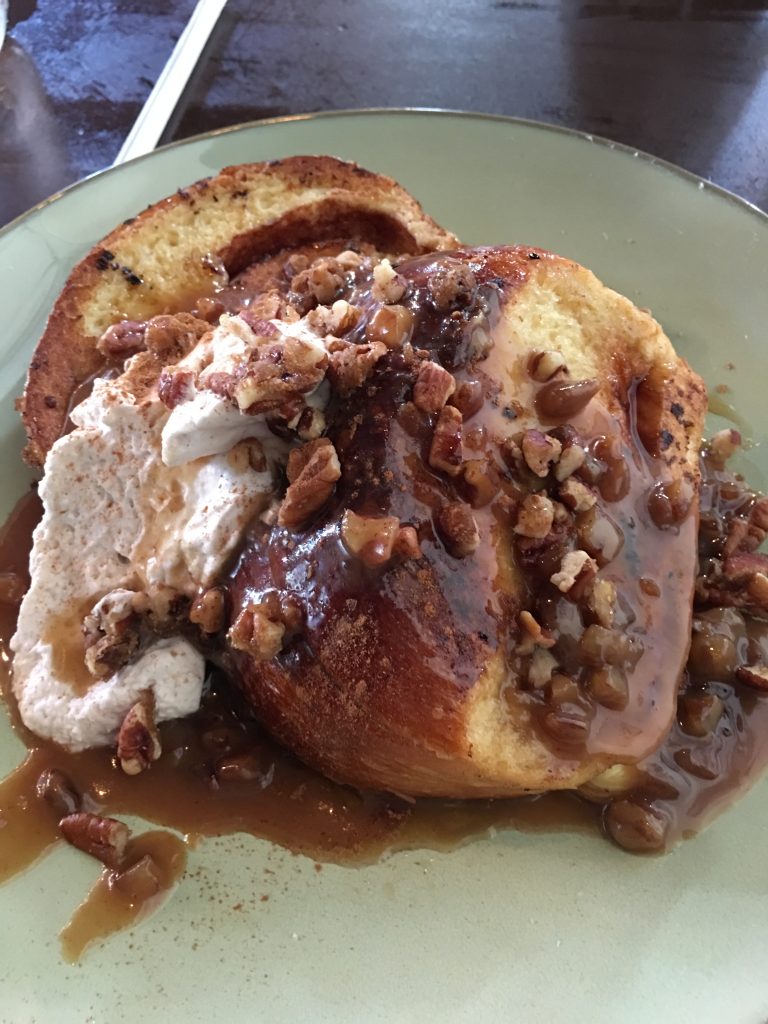
As Janeen brought my meal to the table, I could smell the sweetness of the bourbon praline sauce and the candied pecans. Coupled with the subtle aroma of cinnamon and homemade whipped cream, I could not wait to dive in. Taking my first bite, I have to admit it tasted more like a dessert than breakfast. This rich cinnamon creation, loaded with pecan goodness, was sinfully delicious.
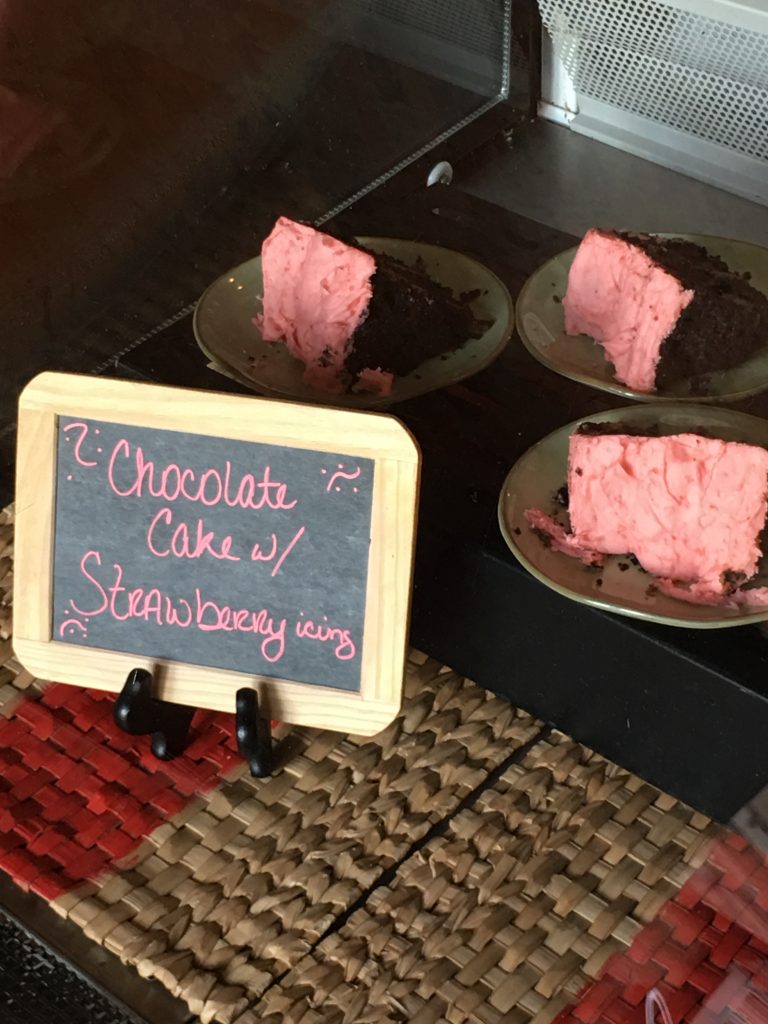
All desserts at The Old Arcana are made from scratch and the selection changes on a regular basis. Behind the counter, there was the carrot cake bread pudding, devil’s food cake, their signature banana pudding, strawberry tart parfait and their chocolate cake with strawberry icing. The temptation was overwhelming, but having had the decadent French toast, I was going to have to pass and plan for dessert on my next visit.
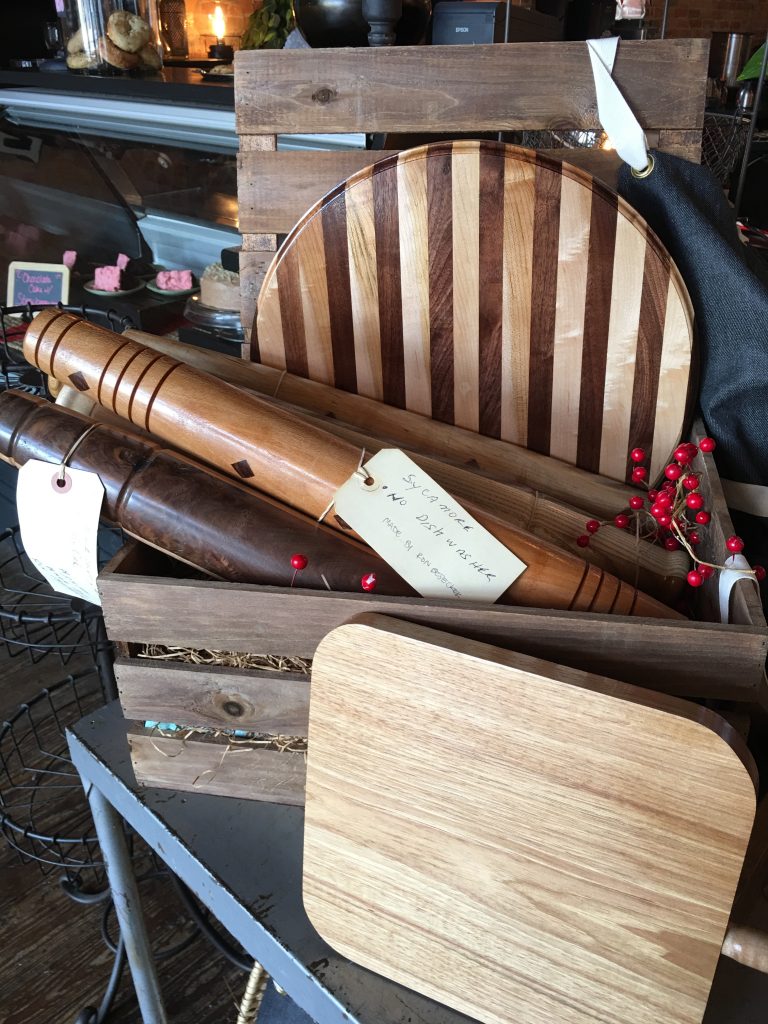
Janeen mentioned that her brother Jeff Besecker was the owner and successful self-taught chef behind some of the most amazing menu items. Her father was instrumental in the renovations of the restaurant, adding some personal touches such as the bench seating along the wall opposite the bar. The restaurant sells some of her father’s beautifully designed walnut and brown maple cutting boards as well as sycamore rolling pins.

After settling my check, I was determined to return soon for another of the restaurant’s top sellers, the Arcana Hot Brown. The Old Arcana Restaurant ranks high on my list of restaurants in the state of Ohio and is a hidden gem located in the farmlands of Darke County. Of course, the next time, I will definitely save room for dessert.
Have you had the opportunity to dine at The Old Arcana Restaurant? I would love to hear about your experience or to recommend any restaurant items that you have tried if you would kindly leave your comments below! Many thanks for reading about my experience at The Old Arcana Restaurant and wishing you many Happy Travels!
Where to Eat:
The Old Arcana Restaurant
109 W. George Street
Arcanum, OH 45304
Telephone: 937 692 0068
The restaurant serves breakfast, lunch and dinner and accepts cash only for payment. The Old Arcana Restaurant also offers cooking classes, which are provided on their webpage. In March of 2016, they began a Supper Club to bring like minded foodies together to enjoy a meal in a slow, engaging environment. This is also an opportunity to meet the chef, the staff and “hear their inspiration behind the month’s dish”. Information about becoming a member of the Supper Club is also listed on their website.
Disclosure: Please refer to our blog disclaimer tab for more information.
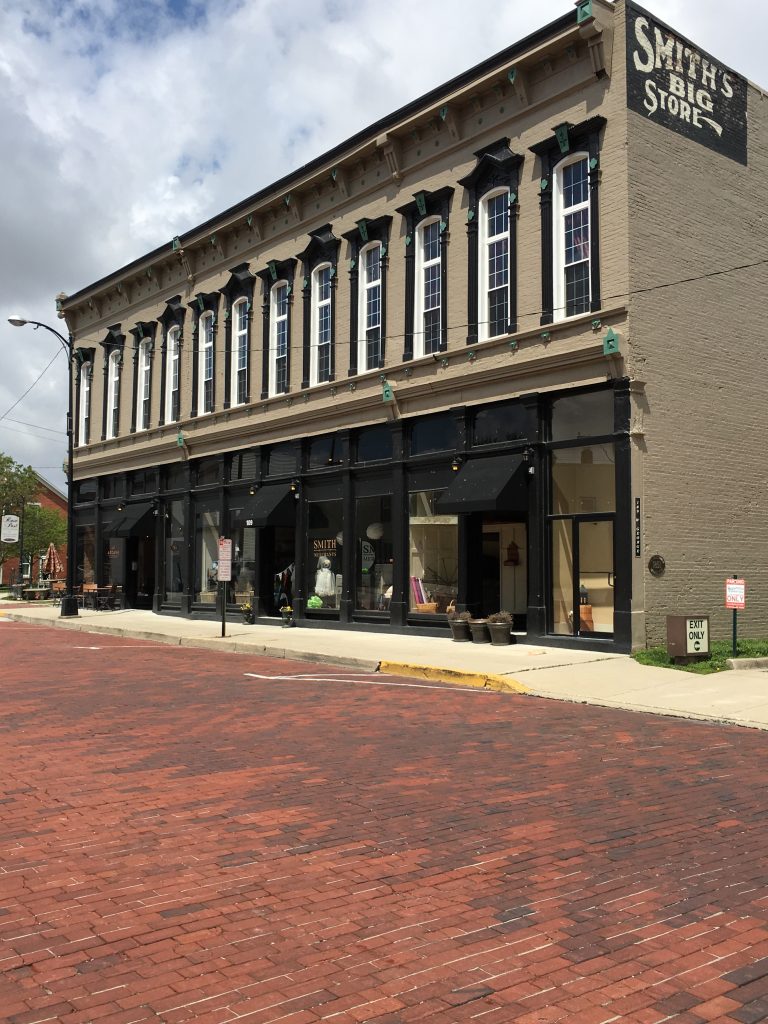
The brick streets of Arcanum and the storefront for The Old Arcana Restaurant
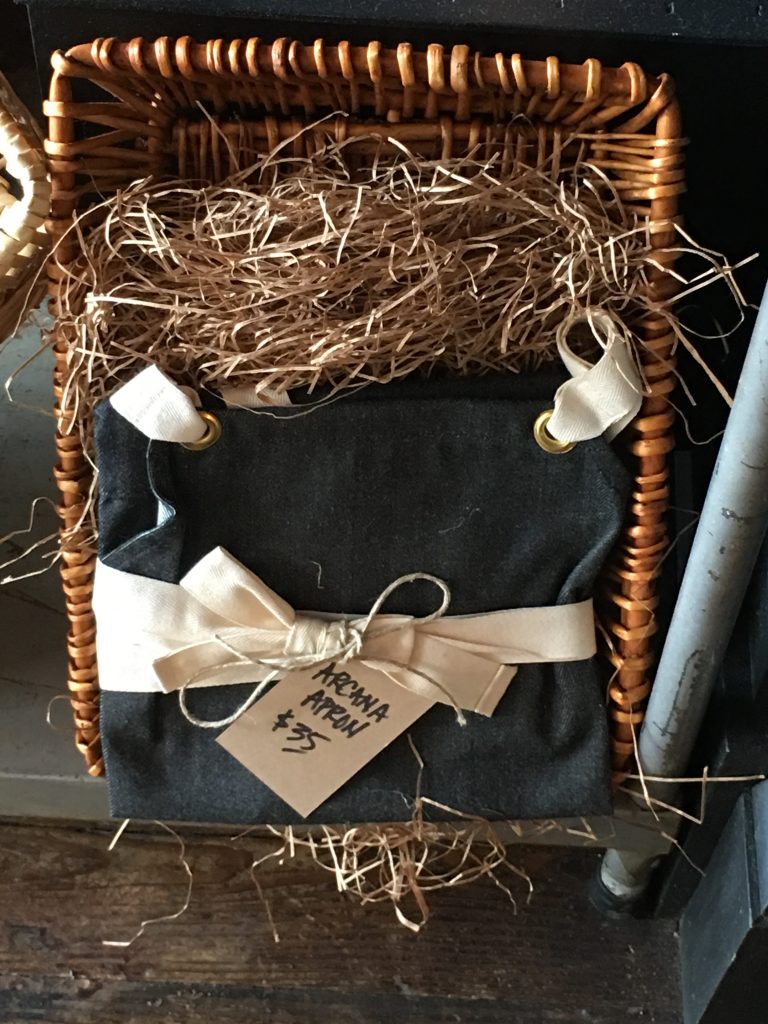
Aprons for Sale at the Old Arcana Restaurant in Arcanum, Ohio
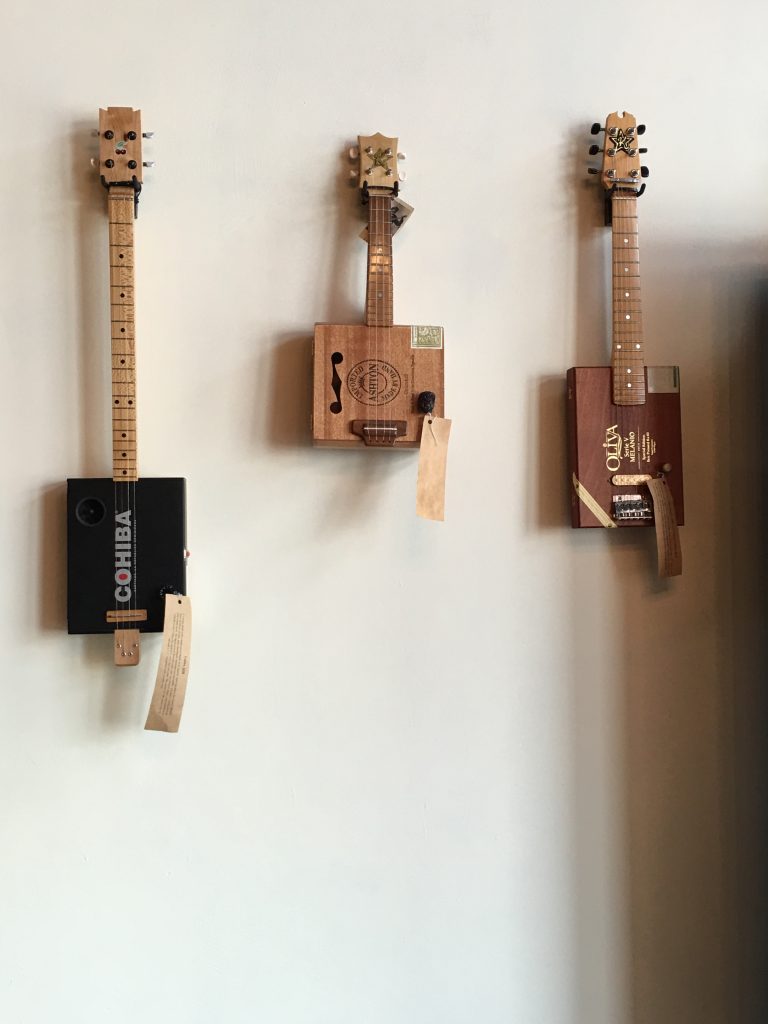
Cigar Box Guitars Available for Purchase at The Old Arcana Restaurant